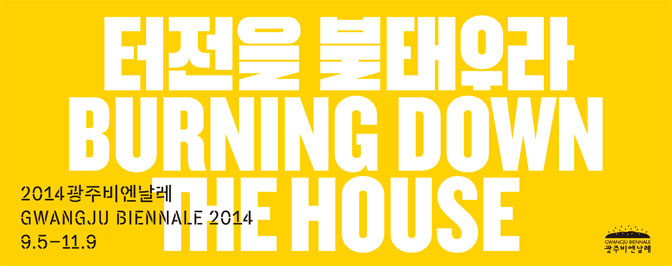10TH GWANGJU BIENNALE 2014
05 Sep - 09 Nov 2014
Burning Down the House
5 September - 9 November 2014
Artistic Director: Jessica Morga
Artists:
AA Bronson, Abbas Akhavan, Akram Zaatari, Allora & Calzadilla, Anand Patwardhan, Andrea Bowers, Anna Maria Maiolino, Anthea Hamilton & Nicholas Byrne, Anwar Shemza, Apostolos Georgiou, Artist Group Dung-ji(Inn Sun Kim), Banu Cennetoglu, Basel Abbas & Ruanne Abou-Rahme, Birgit Jurgenssen, Bok Man Kim, Brenda Fajardo, Camille Henrot, Carlos Motta, Carol Christian Poell, Carsten Holler, Cecilia Bengolea & Francois Chaignaud, Celia Hempton, Cezary Bodzianowski, Charles Atlas, Cornel Brudascu, Cornelia Parker, Dan Flavin, David Wojnarowicz, Dominique Gonzalez-Foerster, Eduardo Basualdo, Edward Kienholz and Nancy Reddin Kienholz, Ei Arakawa & Inza Lim, Eko Nugroho, El Ultimo Grito, Gabriel Orozco, Gavin Kenyon, George Condo, Geumhyung Jeong, Gulsun Karamustafa, Gunes Terkol, Hammed Abdella, Heman Chong, Heri Dono, Hidemi Nishida, Huma Mulji, Jack Goldstein, Jai Hyoung Hwang, James Richards, Jane Alexander, Jeong A Koo, Jeremy Deller, Jianyi Geng, Jonathas de Andrade, Ken Unsworth, Lee Bul, Lionel Wendt, Liu Chuang, Lubaina Himid, Mino Lim, Mircea Suciu, Mrinalini Mherjee, Naufus Ramirez-Figueroa, Neungkyung Sung, Nicole Eisenman, Nil Yalter, Okin Collective, Olafur Eliasson, Otto Piene, Pierre Huyghe, Piotr lanski, Prem Sahib, Renata Lucas, Renate Bertlmann, Robert Heinecken, Roberto Cabrera, Rodel Tapaya, Roman Ondak, Rosemarie Trockel, Sehee Sarah Bark, Seulgi Lee, Sharon Hayes, Sheela Gowda, Shooshie Sulaiman, Sterling Ruby, Stewart Uoo, Snam Yun, Sung Hwan Kim, Sungchul Yang, Tahmineh Monzavi, Tang Dixin, Tetsuya Ishida, Tomoko Yoneda, Ulrike Ottinger, Urs Fischer, Vlassis Caniaris, Wan Lee, Woon Hyoung Choi, Xiangqian Hu, Xiaodong Liu, Xooang Choi, Yamashita Kikuji, Yoshua Okon, Young In Hong, Young Soo Kim, Yves Klein
Burning Down the Houseexplores the process of burning and transformation, a cycle of obliteration and renewal witnessed throughout history. Evident in aesthetics, historical events, and an increasingly rapid course of redundancy and renewal in commercial culture, the Biennale reflects on this process of, often violent, events of destruction or self-destruction―burning the home one occupies―followed by the promise of the new and the hope for change.
In the 1930s the critic Walter Benjamin coined the term ‘Tigersprung’ (the tiger’s leap) for a new model of history where the past is activated in and through the present within a culture industry that demands constant renewal. What can the ‘Tigerspung’ mean for today’s ‘tiger economies’ like South Korea in a context where economic and political powers deliver the eternally new of fashionable commodities and industrial progress at the apparent expense of a cultural past?
Burning Down the House looks at the spiral of rejection and revitalization that this process implies. The theme highlights the capacity of art to critique the establishment through an exploration that includes the visual, sound, movement and dramatic performance. At the same time, it recognises the possibility and impossibility within art to deal directly and concretely with politics. The energy, the materiality and processes of burning ― the manner in which material is changed and destroyed by flames into the residue of dramatic interventions or remnants of celebrations ― have long informed artistic practice. The transformative powers of fire are central to the way in which this exhibition has been imagined.
Rather than a simple reference to a leftfield pop anthem from the early 1980s, the title reflects the double significance of the proposed Biennale-concept. By fusing physical movement with political engagement, it animates the concept for the decennial of the Gwangju Biennale. When the US-Band Talking Heads were debating the title and chorus of ’Burning Down the House’, their most recognised track, members of the band remembered being at a Funkadelic-concert where George Clinton and the audience swapped calls to ‘Burn Down the House’. This hedonism by the P-Funk crowd on the dance floor was then turned into an anthem of bourgeois anxieties by the New York-based band. This dual meaning of pleasure and engagement serves as the defining spirit of the 10thGwangju Biennale.
Burning Down the Houseexamines the potential of art as movement, by exploring the efforts made by contemporary artists to address personal and public issues through individual and collective engagement, as well as demonstrating how challenging these efforts and their impacts have become. Contrary to museums, with their often hegemonic cultural policies and interest in denoting legacies and traditions, the biennale is a mobile and flexible event, which offers a spectrum of creative expressions that are immediate, contemporary and topical, making the proposed debate of art as movement fitting for the space of Gwangju ― both geopolitically and as an institutional alternative.
Burning Down the House, the 10thGwangju Biennale, is curated by Jessica Morgan, Artistic Director of the Biennale and The Daskalopoulos Curator, International Art, Tate Modern. FatosUstek and Emiliano Valdes are Associate Curators for the Biennale, EnnaBae is Associate Curator for Performance and Teresa Kittler is Assistant Curator.

